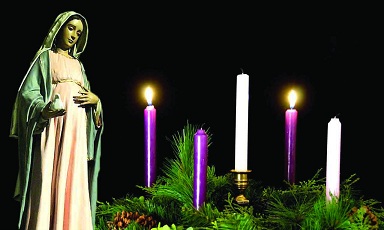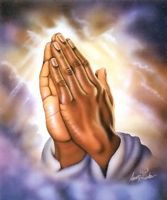The Titles of Mary
By Ed de Vera

Of all things Catholic, perhaps the most misunderstood if not disturbing to our Separated Christian Brethren, are the numerous titles of Mary. Most of them feel that these titles and the devotions connected therewith give her more importance than her Son, Jesus. Consider a few: Mother of God, Queen of Angels, Our Lady of Perpetual Help, etc.; non-Catholics find these and other titles superfluous, thus their most common plaint is Catholics have made Mary a goddess and are therefore guilty of idolatry.
Actually the titles of Mary are all biblically rooted. However our Protestant brothers, cut off for five centuries from the Apostolic Tradition whence all devotional traditions from practice of the Faith emanate, are adrift and consequentially cannot relate. When the Reformers rejected Christ’s Real Presence – body, blood, soul and divinity in Eucharist – they split into four distinct separate groups which over time splintered to today’s sad reality of over thirty-five thousand independent groups that call themselves churches in denominations, sects, non-denominational assemblies, faith fellowships, cults, etc.
Sad too is how a good number of Catholics fail to comprehend the Marian Titles. In fact many that have deserted the Faith have done so from a failure to understand Mary in the life of the Church. Of the numerous Marian titles, four are Church dogmas: Mother of God, Perpetual Virgin, the Immaculate Conception, and the Assumption. As dogmas these are binding on the faithful, yet loyal adherence must also be well informed; one has to be well-catechized not only as a safeguard against falling away but more importantly to grow in understanding and love, to thereby share the beauty of the Marian dimension of the Faith with others.
Surely the mother of all Mary’s titles must be the Church’s first Marian Dogma: Teotokos, God Bearer or Mother of God. It was promulgated in AD 431 when the Bishops convened at the Council of Ephesus to deal with the Nestorian heresy that espoused two separate persons in Christ – one divine, the other human – contrary to the Apostolic teaching of the hypostatic union of the divine and human natures in the one person of Jesus Christ. Mary, the heresy alleged, was only mother of the human, not the divine Christ. In condemning the heresy, the first Marian Dogma was proclaimed by the Church.
The classic proof text of Mary’s divine maternity is in the Bible. Elizabeth inspired by the Holy Spirit calls her, “mother of my Lord” (Lk 1:43); lord, adonai in Hebrew was a title for God. In that singular privilege as Mother of the Redeemer, Mary assumes a special role. After entrusting His Mother to the beloved disciple and the disciple to her, Jesus ends His liturgy on earth and pronounces, “It is finished.” With Christ’s mission completed, Mary, the first disciple, first Christian and model of the Church, assumes her maternal role as the spiritual mother of the New Creation. This introduces us to a corollary title: Queen Mother.
In the Kingdom of Judah the queen mother reigned alongside her son, the king. Of twenty-two Davidic kings mentioned in 1 and 2 Kings and 1 and 2 Chronicles, twenty-one queen mothers are listed. This importance was not lost on the Fathers of the Church who formulated the Doctrines from the divinely revealed truths in Sacred Scripture and Sacred Tradition.
It was Solomon, the son of David, who instituted the office of Queen Mother when he installed his mother Bathsheba to reign with him (1 Kgs :2:19); thereinafter the office of the gebirah or queen mother became a salient feature of the Davidic Kingdom. Interestingly, the Queen Mother’s function was intercessory, to bring to the king’s attention her people’s needs. Mary is the New Covenant fulfillment of Davidic gebirah who reigns alongside her divine Son Christ our King and intercedes for us.
Another of Mary’s many titles is Virgin. Since the earliest days, all Christians believed in her perpetual virginity. This was challenged in AD 380 by a heretic bishop, Helvidius by name, who explained the “brothers” of Jesus in the Bible as other children of Mary and Joseph. St. Jerome branded this “…novel, wicked, and a daring affront to the faith of the whole world,” citing the Scriptures and teachings of the Apostolic Fathers Ignatius, Polycarip, Irenaeus, and Justin Martyr to defend the Doctrine.
Contemporaries of Jerome – Ambrose, John Chrysostom, and Augustine – as well as subsequent Church Fathers unanimously concurred with the Doctrine. At the Lateran Synod of 659, Pope St. Martin I formally proclaimed the Dogma of Perpetual Virginity of Mary: she had remained virgin – ante partum, in partu, et post partum – before, through, after conception and birth of Jesus.
Mary’s Perpetual Virginity was upheld by the Fathers of the Reformation: Luther, Zwingli and Calvin vehemently defended Mary’s perpetual virginity, which, unfortunately was lost in the continual fragmentation of the children of the Reformation. Interestingly, the followers of Mohammad also believe this doctrine; an excerpt from the Koran: And she who had remained a virgin… We have breathed our Spirit upon her. We have made of her and her Son a Sign to the world (Sura 66 v. 12). Islam considers Maryam (Mary) as the greatest of all woman; several verses in the Koran attest to this. As Mohammad lay on his deathbed, he told his daughter Fatima that at the end of her life when she enters Paradise, only one woman would be greater than she, the Sayida (the Lady), the Moslem title for Maryam.
We often refer to Mary as Our Lady: Our Lady of the Holy Rosary; Our Lady of Peace and Good Voyage; Our Lady of Good Counsel. In Latin and Eastern branches of the Church in every culture from every time and clime the Mother of God has been called Mother, Queen, Virgin, or Lady of their realm: Nuestra Seňora de Guadalupe, Nuestra de Peňafrancia, Nuestra de los Angeles, Our Lady of Manaog, Our Lady of Lipa, Ina ng Rizal.
There are three major litanies to honor Mama Mary. Most well known is the Litany of the Blessed Virgin approved by Pope Sixtus V in 1557 which contains several titles and accolades in invocations; it is sometimes referred to as Litany of Loreto where it was first prayed in 1558. Some of the invocations predate that period, from the 11th century or earlier.
Constraints of space limit us from studying each and every individual title; suffice it to say all are scripturally based – Old Testament types of Mary in the Bible and taken from her special relationship with the One Triune God.
Mary, who is the favored Daughter of the Father, Spouse of the Holy Spirit, and Mother of the Redeemer, is our Mother whose constant maternal advice is, “Do whatever He tells you.”
Get our Free Newsletter!
Get the latest articles straight to your inbox - Free!
Click here to return from The Titles of Mary to Catholic Beliefs.
Join Our Community!
Got a Prayer Request?
Click here to submit a prayer request!

Donate to this Site!
Help support Totus Tuus, Maria! Click here to donate.





New! Comments
Have your say about what you just read! Leave me a comment in the box below.